Coronavirus: Push for cycling despite safety fears
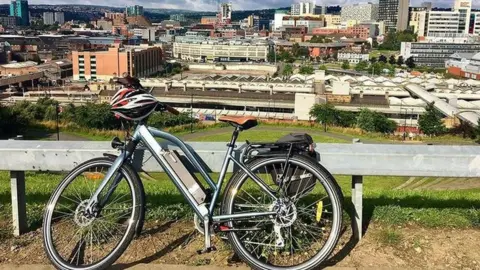 BBC
BBCUK towns and cities must be made cycle-friendly if a change to commuting habits is to succeed, campaigners say.
Cycling and walking are being backed as alternatives to public transport as people who are not able to work from home, are encouraged back to work.
The latest government survey data before lockdown, however, showed three in five people thought cycling on the road was too dangerous - 61%.
Campaign groups said infrastructure improvements would be key.
The government has released a £250m "emergency active travel fund" aimed at helping towns prevent overcrowding as lockdown is lifted and it has issued guidance to councils.
Cycling UK said now was a "golden opportunity" to encourage people.

'I had never cycled in the city before'
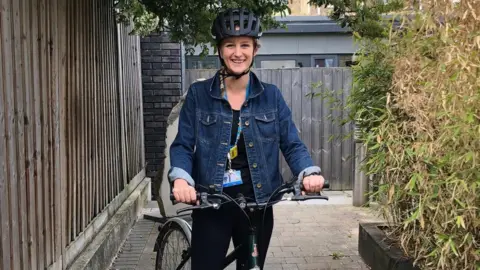 Lizzie Farrant
Lizzie FarrantMidwife Lizzie Farrant has begun cycling to work and said she "definitely" would not have done so if it were not for the current crisis.
"I live about two miles away from where I work so it's reasonable enough for me to walk into work.
"I live alone in London and feel quite isolated at the moment.
"With the relaxation of the [lockdown] measures, I realised that not only could I benefit from avoiding public transport and cycling to work but I could benefit with meeting up in a socially-distanced way with my brother."
Lizzie had difficulty finding a bike - "all the major retailers of bikes were sold out of bottom range ones, I think everybody has done the same thing" - but eventually found a second-hand one.
Now she believes she will continue to cycle after lockdown ends.
"I'd never cycled in London because of the traffic but also bike maintenance but then Halfords are doing a free bike service for NHS staff," the 39-year-old said.
"I'm looking at the cycle ways across London. I would like to keep going on with it."

What is being done to make cycling safer?
New cycle lanes, wider pavements and low traffic zones in residential areas are among the emergency measures being put in place, the Local Democracy Reporting Service has said.
Additional cycle lanes are planned in Birmingham and Leicester, while Sheffield and Bristol city councils are fast-tracking plans to reduce car use.
Portsmouth hopes to make some roads in the south of the city more cycle-friendly during lockdown.
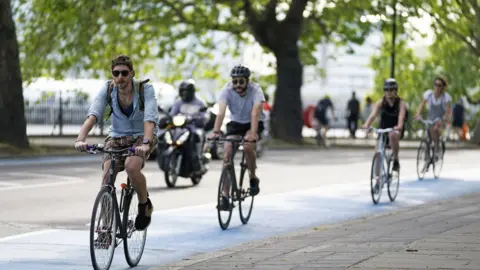 Aaron Chown/PA Media
Aaron Chown/PA MediaTemporary plans in Newcastle city centre include one-way walking routes, the removal of benches and other street furniture, new cycle lanes, and the deployment of marshals to make sure people follow the new system.
In Brighton, there is meanwhile a proposal to turn part of the A259 into cycle lanes.
During a virtual committee discussing the plan reported by the Local Democracy Reporting Service, Brighton councillor Mac Cafferty said: "We can't go back to our failed fume-filled past."
Transport for London (TfL) is introducing new cycleways between Kensington Olympia and Brentford as well as Tower Hill and Greenwich and widening some pavements in North London.
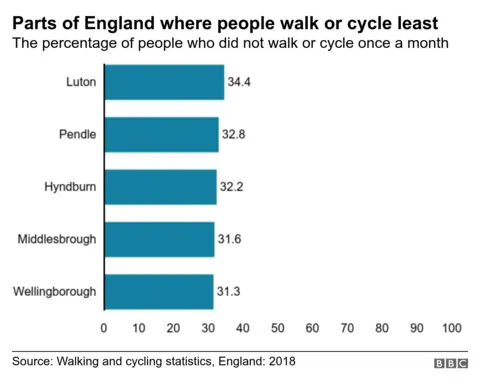
Cycling UK said infrastructure changes would be important to change perceptions of how safe it was to cycle.
"We know that the thing that will get people cycling is if they feel safe and pop-up cycle lanes and other infrastructure will help," it said.
The group has encouraged residents to write to their local council asking for improvements to cycle infrastructure, and said some 6,000 people have already done so.
The latest government survey data on people's transport habits in the UK from 2018, however found that one in five people did not walk or cycle once in a month.
And the Conservative group in the London Assembly said plans to encourage Londoners onto a saddle instead of public transport would not work for some.
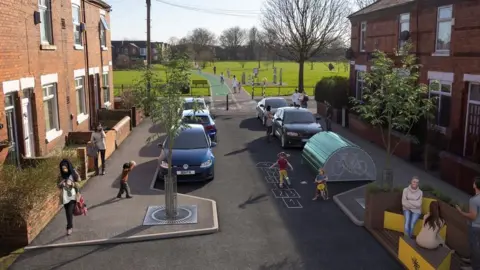 Transport for Greater Manchester
Transport for Greater Manchester"It's simply not possible for many Londoners who live in the outer boroughs to cycle or walk into work," said the Conservative transport lead, Keith Prince.
"If the mayor wants to avoid them using cars, he needs to make a plan to get London's transport moving safely now."
Rod McKenzie of the Road Haulage Association has said infrastructure changes proposed felt "anti-motorist" when "all those methods of transport were essential for economic recovery" after the coronavirus pandemic.
Darren Shirley, chief executive of the Campaign for Better Transport, said increased cycling to work might work well in bigger cities such as Manchester or London, but it would be a greater challenge in rural areas.
"The biggest barrier [to cycling to work] is people's distance to travel, and that won't change.
"A lot of people will rely on cars, or they won't travel if they don't get on public transport.
"We've had people get in touch who have heard 'don't use public transport', who aren't sure how they're going to get to work; they fear losing their jobs.
"Cycling isn't right for them because of the distance they've got to travel or the route is more dangerous.
"If you cycle in London it's very different to say, Northumberland or the rural South West."
He said the temporary measures to increase road space for cyclists and pedestrians could help in the short term, but more measures were needed to enable public transport to run safely as more people returned to work.


- LOCKDOWN UPDATE: What's changing, where?
- SCHOOLS: When will children be returning?
- EXERCISE: What are the guidelines on getting out?
- THE R NUMBER: What it means and why it matters
- LOOK-UP TOOL: How many cases in your area?

Reporting team: Anna Khoo, Paul Lynch and the Local Democracy Reporting Service
